VAT Report: Report Filters
- The contents of this User Manual will consist of the following information:
- Report sub-tabs
- VAT Analysis
- VAT Form
- Journals posted directly to VAT account (CLI2)
- Group Report
- Transaction Detail
- Export and Print
Report sub-tabs
All the sub-tabs of the various VAT Reports.
VAT Analysis
A detailed summary of all VAT qualifying transactions that have been posted, sorted by the different VAT Categories and VAT Groups.
- Once the VAT report has been generated the VAT Report tab, VAT Analysis sub-tab will open.
- For an explanation on where to access the VAT Report, please refer to the user manual: VAT Report (Overview).
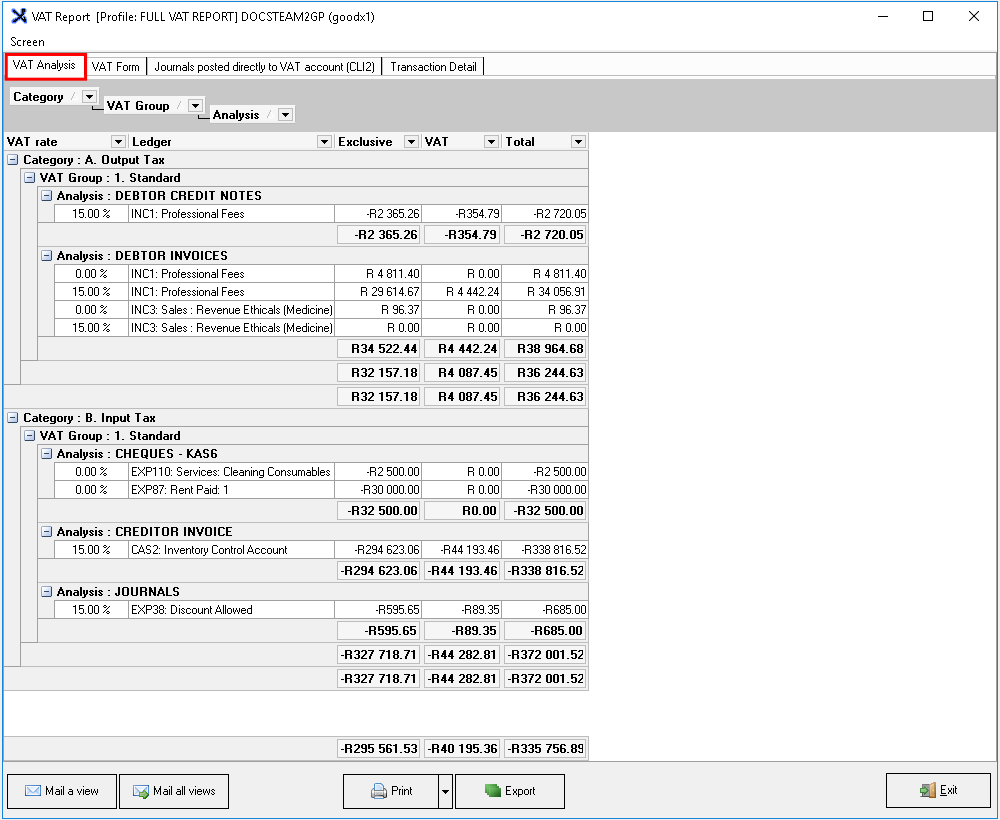
Please Note: The report will generate according to the Settings and Parameters that have been set up. For a detailed explanation on how to set up a VAT Report, please refer to the user manual: VAT Report: Settings and Parameters.
- The report will be divided into columns:

- An explanation will be given for each column:
- VAT Rate: The Value Added Tax rate that is regulated by the South African Revenue Services. The current VAT rate in South Africa is 15 %. This is the rate at which the transactions were posted.
- Ledger: The ledger account where the full transaction was posted, where VAT was applicable when it was first processed. The ledger account number to which the transaction was posted. A ledger account is a financial book (or record) that organises entries by account and collects historical transaction data from a journal.
- Exclusive: The total line amount that excludes VAT, before VAT is calculated. Line Total - 15 % = Excl. VAT.
- VAT: The total amount of VAT that is charged on the line total. Line Total - Exclusive Amount = VAT.
- Total: The total that includes the VAT amount. Exclusive Amount + VAT Amount = Total.
Please Note: Each category will have an overall total that will contribute to the grand total at the bottom of the tab.
- The report will be divided into default Categories:

- Category A. Output Tax: Calculated VAT that has been received as a result of the sale of goods and the rendering of services. The total amount of VAT that the practice has charged on transactions that is payable to SARS.
- Category B. Input Tax: Calculated VAT that the practice has paid when purchasing goods and when services have been rendered to the practice. The total amount of VAT that the practice has paid and is able to claim back from SARS.
- Totals: The total of the report will be the sum of all the categories that are added together Exclusive of VAT plus the VAT amount (15 %) which will equal to the total inclusive of VAT.
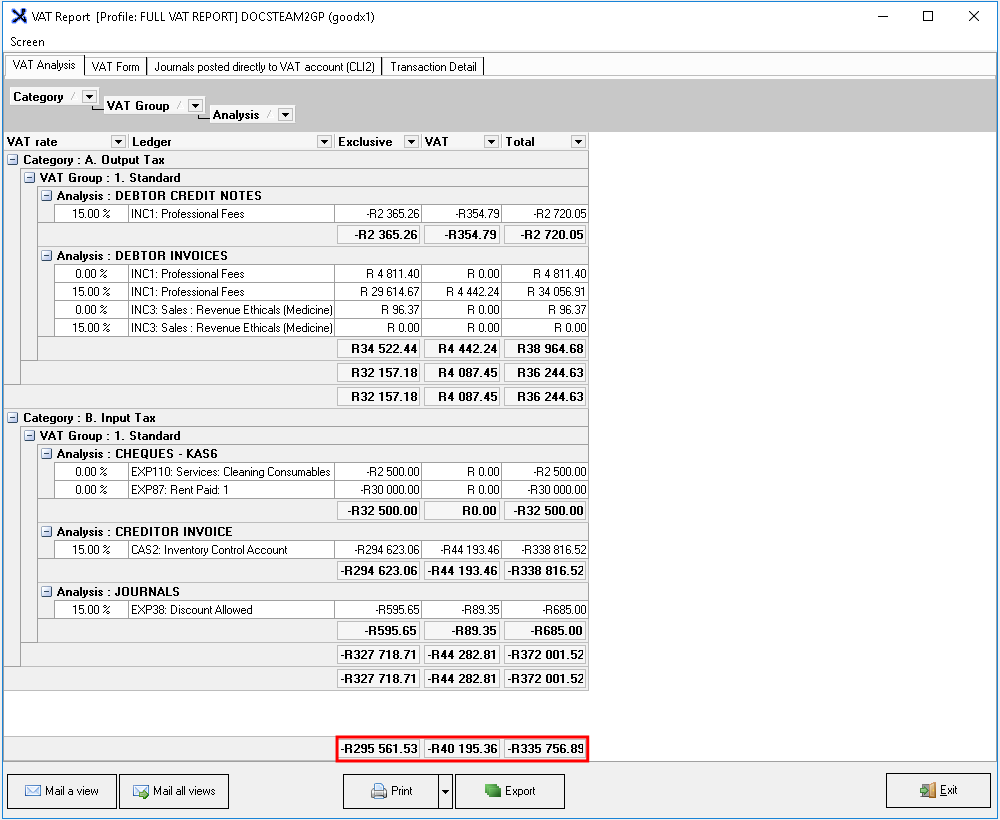
Please Note: If the totals are in a negative the practice is able to claim back the negative amount and when the amount is in a positive, this will be the amount the practice is required to pay over to SARS.
VAT Form
Assists the user to be able to know what amounts should be filled in on the VAT form that will be submitted to the South African Revenue Service. For an example of the form and a comparison thereof, please see the PDF document: VAT Report Compare.
- Click on the VAT Form tab to access the information regarding the VAT that will need to be paid to SARS.
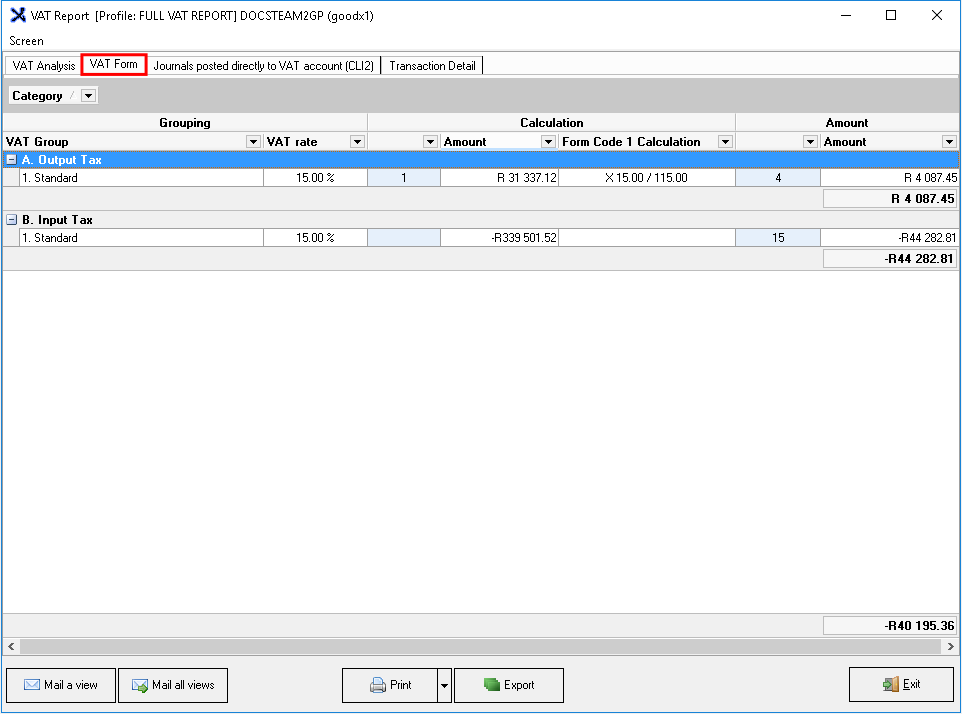
- The VAT Form Report will be divided into columns:

- An explanation will be given for each column:
- Grouping: To classify and arrange transactions that belong to the same category together.
- VAT Group: The type of VAT that is charged.
- VAT rate: The Value Added Tax rate that is regulated by the South African Revenue Services. The current VAT rate in South Africa is 15 %.
- Calculation: The calculations that have been used to work out the VAT totals.
- Amount: The amount that is used to calculate the VAT that will need to be paid to SARS.
- Form Code 1 Calculation: The calculation that has been used to calculate the Form 1 values.
- Blue Column: Indicates the codes that will be used to fill in the forms at SARS, these codes will assist the user when the user fills in the forms to know where to fill in what on the forms.
- Amount: A column that relates to the amounts that will be on the report.
- Blue Column: Indicates the code that the amount will be allocated to, that the user will use to fill in the forms at SARS.
- Amount: The line total of VAT that has been calculated on the specific line. Amount = Calculation Amount + Form Code 1 Calculation.
- The report will be divided into default Categories:

- A. Output Tax: Calculated VAT that has been received as a result of the sale of goods and the rendering of services. The total amount of VAT that the practice has charged on transactions that are payable to SARS.
- B. Input Tax: Calculated VAT that the practice has paid when purchasing goods and when services have been rendered to the practice. The total amount of VAT that the practice has paid and is able to claim back from SARS.
- Totals: The total of the report will be the sum of all the categories that are added together, this will then be the final amount that the practice will need to pay to SARS.

Please Note: If the totals are in a negative the practice is able to claim back the negative amount and when the amount is in a positive, this will be the amount the practice is required to pay over to SARS.
Journals posted directly to VAT account (CLI2)
Shows all the details regarding Journals that have been posted directly to the VAT account. It is not advised to post journals to the VAT account unless an error was made whilst posting VAT transactions.- Click on the Journals posted directly to VAT account (CLI2) sub-tab to access the information regarding the details of journal transactions that were posted directly to the VAT account.

- The Journals posted directly to VAT account (CLI2) Report will be divided into columns:

- An explanation will be given for each column:
- Transaction Date: The date that the Journal transaction took place at the practice.
- Capture Date: The date on which the journal transaction was posted.
- Detail: The system will pull through the transaction description as it was filled in when the journal transaction was captured onto the system.
- Description: The transaction description that was entered when the journal transaction was captured onto the system.
- Amount: The journal amount that was posted.
- VAT: The VAT amount that is applicable on the transaction.
- User: The user that captured the transaction onto the system.
Group Report
Allows the user to group the report to their preference so that they are able to see very specific information regarding the VAT Report.- Click on a column header to drag the header to the Drag a column here to group by that column field to group the entire report according to the selected header.

- The information on the report will now be grouped according to the header that was dragged into the grouping field.

- Totals: The sum of all the Journals posted directly to VAT account (CLI2).
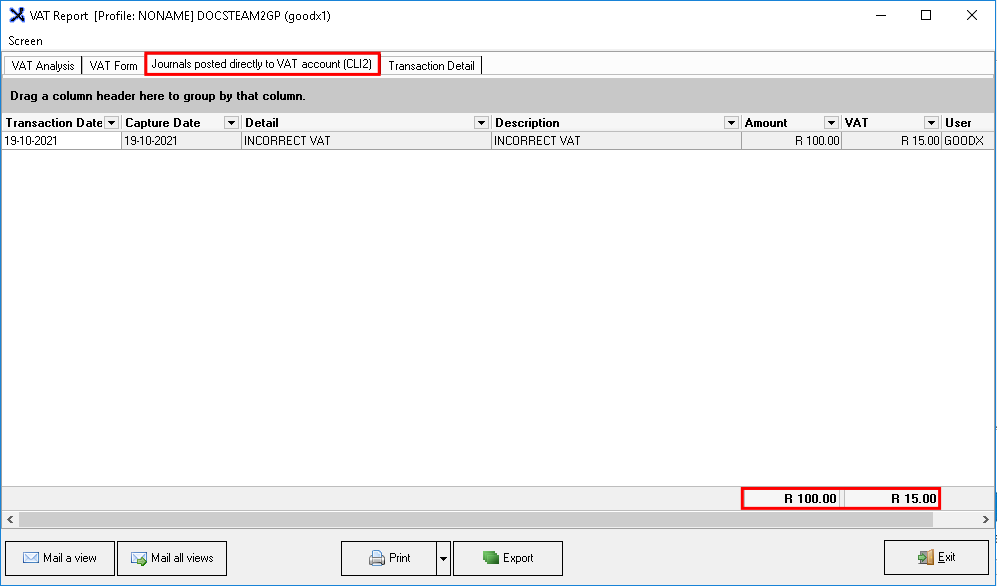
Transaction Details
A detailed list of all VAT qualifying transactions that have been generated according to the report that has been generated.
- Click on the Transaction Details tab to access the information regarding the details of the transactions that qualify for VAT and where VAT has been posted on the transactions.
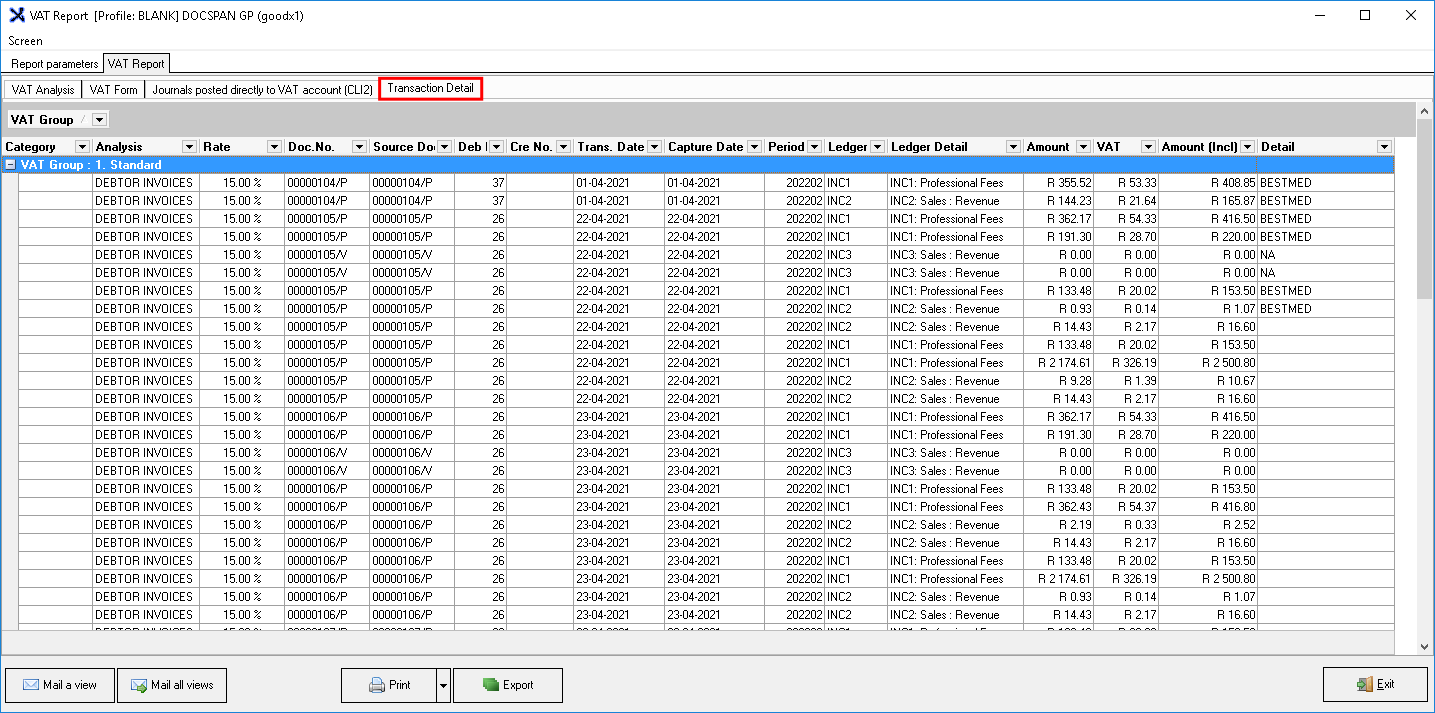
- The Transaction Details Report will be divided into columns:
![]()
- An explanation will be given for each column:
- VAT Group: The group to which the VAT has been allocated.
- Analysis: The type of transaction that was posted.
- Rate: The Value Added Tax rate that the transaction was posted to as regulated by the South African Revenue Services. The current VAT rate in South Africa is 15 %.
- Doc.No.: The document number on which the VAT transaction has been posted.
- Source Doc.: The document number where the information of the VAT transaction that was posted, can be found. The document code will be dependant on the type of transaction that was posted.
- Deb No.: The Debtor account number on which the transaction was posted.
- Cre No.: The Creditor account number on which the transaction was posted.
- Trans. Date: The date that the transaction took place at the practice.
- Capture Date: The date on which the transaction was captured and posted on the system.
- Period: The financial period (year and month) that the transaction was posted in.
- Ledger: The ledger account number to which the transaction was posted. A ledger account is a financial book (or record) that organises entries by account and collects historical transaction data from a journal.
- Ledger Detail: The name of the ledger account and details of the ledger account that was used to post the transaction.
- Amount (Excl): The total of the transaction that was posted excluding 15 % VAT.
- VAT: The VAT amount that is applicable on the transaction. 15 % of the total amount.
- Amount (Incl): The total amount of the transaction that was posted including VAT. VAT exclusive amount plus 15 %.
- Detail: The system will pull through the description that is on the bank statement when it was imported to perfectly match the statement descriptions.
Export and Print
Allows the user to Export and Print the VAT Reports.Export
Allows the user to save a copy of the VAT Report to a different file format in order to open it at a later stage in a program that supports the selected file format.
- Click on the Export button to save the list on the computer.

- The Save As screen will open.

- Navigate to where the user would like to save the file on their computer.

- File Name: Add a unique file name to the file.

- Save as Type: The type of file that will be used to save the VAT Report on the user's computer.
- Select the file type from the drop-down menu that the file will be saved as.
- Click on the Cancel button to close without saving.

- Click on the Save button to save the file and return to the VAT Report screen.

Allows the user to print a hard copy of the VAT report.
- Click on the Print button to print out the VAT report.

- The print preview of the selected VAT Report will open.
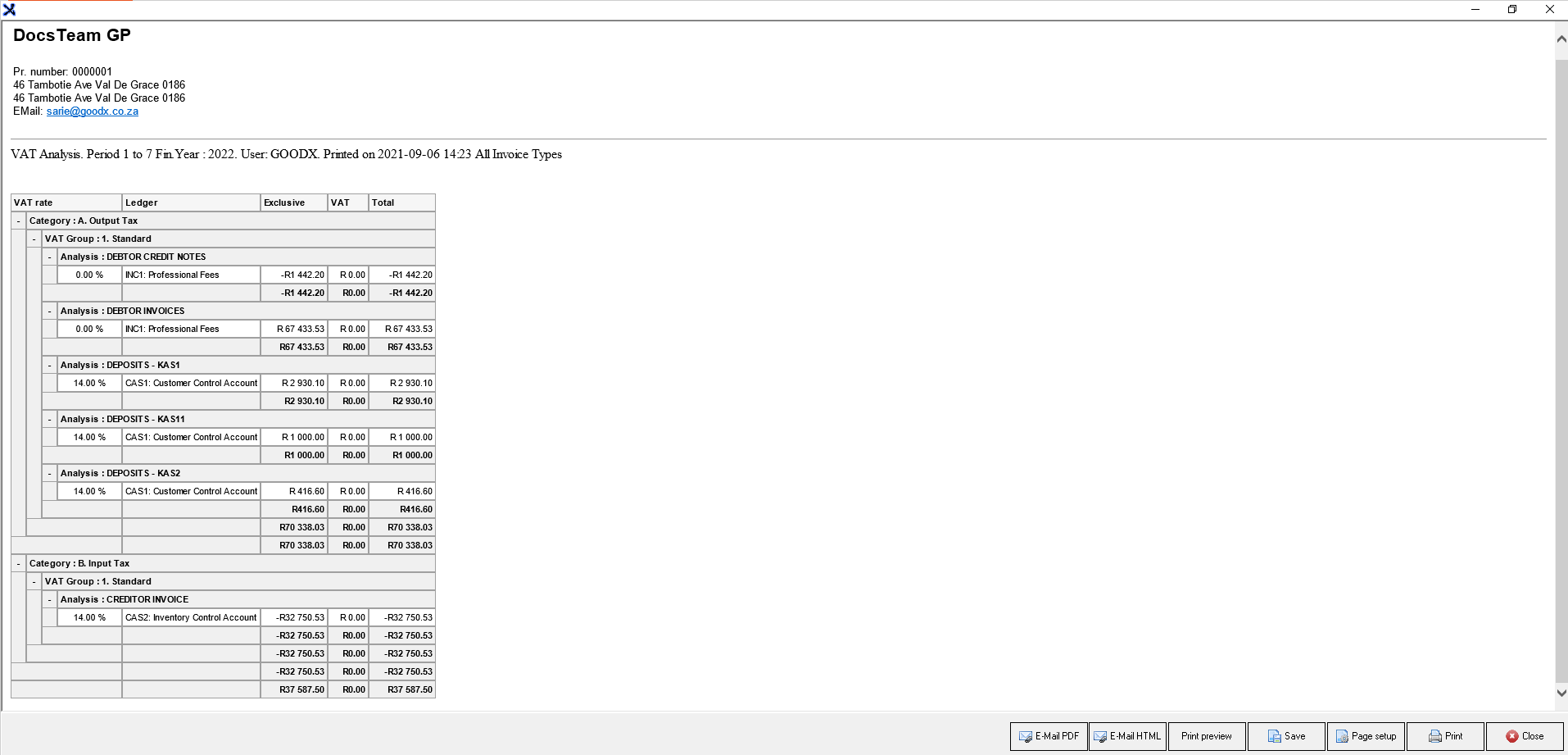
Please Note: That only the VAT Report tab that has been selected will print to the screen.
- The VAT Report will have E-mail and Print options, for more information regarding these options please refer to the user manual: Options to Print.
- Click on the Close button to exit the print preview screen and return to the VAT Report screen.

- Click on the Exit button to return to the Choose a Profile screen.
